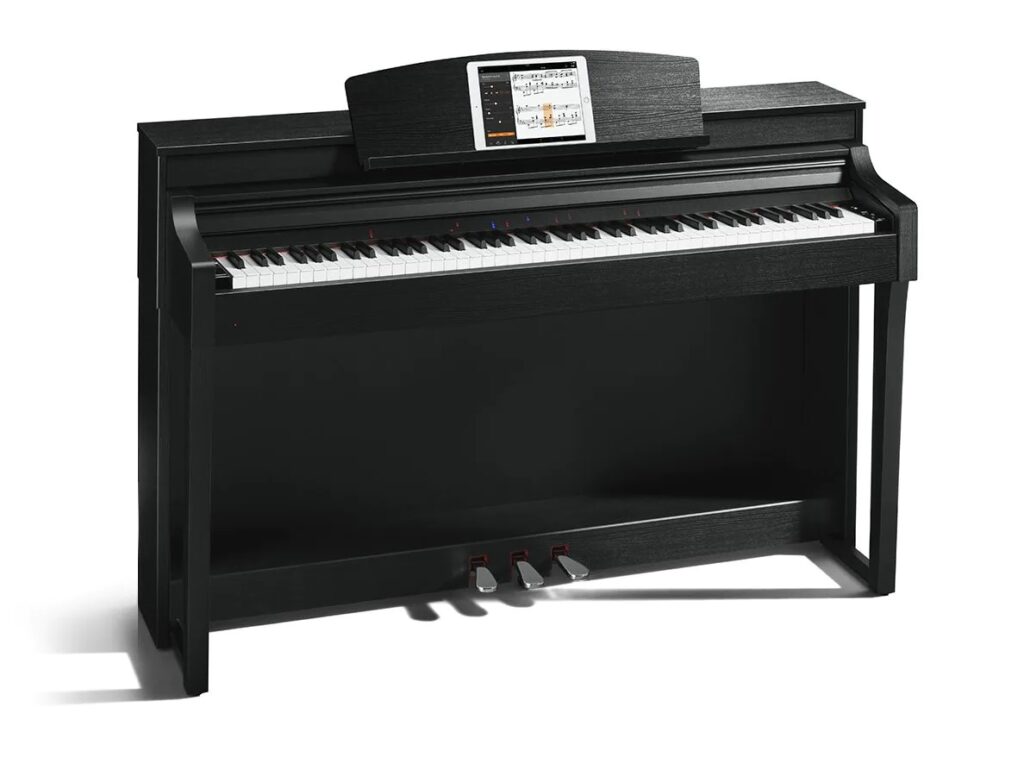Happy New Year!
It’s been a pleasure to ring in the new year with a Yamaha CSP-170 Clavinova Smart Piano. If you’re not familiar with the CSPs, check out my articles about the CSP-100 series and the now current CSP-200 series.
In short, the CSP pianos combine Yamaha’s Clavinova piano technology, learning features (score display and playback, stream lights) and basic auto-accompaniment into a single traditional home piano form factor. The CSPs eschew a complicated user interface, opting for a minimalist, two-button front panel: power OFF/ON button, FUNCTION button, and volume slider.
First and foremost, CSPs are Yamaha digital pianos, as Yamaha likes to say. In this post, I concentrate on the CSP-170 as a home piano. I bought the CSP-170 at a close-out price as Yamaha was clearing inventory when Series 200 deliveries began.
Appearance
I rarely discuss an instrument’s physical appearance in much depth as synth and arranger front panels are “seen one, seen ’em all.” The CSP-170, however, sits in our high-traffic dining room. You can’t miss it!
Our CSP-170 is the matte black model. The matte finish is the best match for our contemporary house. The matte black model costs a bit less than the polished ebony — not really a concern.
The CSP-170 looks like the traditional spinet piano — the old family piano that we ditched just before moving out West. The CSP-170 has attractive clean lines and fits into the contemporary styling of our home. As a piece of furniture, it is constructed solidly and feels like a quality instrument. Definitely a step up from Arius.
I originally considered a P-515 “portable” digital piano and stand. When Yamaha announced close-out pricing, it made sense to step up to the CSP-100 series. A P-515 on its stand is not as physically attractive or formal as the CSP. The CSP cabinet allows for a better more powerful sound system than the P-515 as well.
CSP-170? Heck, yeah.
The CSP-170 piano samples and playability are on par with the P-515. The main pianos are the Yamaha CFX and Bösendorfer Imperial. I played them both during my piano quest and I still enjoy playing them today.
I prefer the CSP-170 sound system over the P-515. The CSP-170 has bi-amplified speakers: woofers in a downward facing speaker box and mid/high ports left and right at chest level. The P-515, like many portables, has bi-amplified upward firing speakers. The P-515 sounds brighter due to the direct sound from its speakers. The CSP-170 sound field is similar to a spinet; the sound is indirect and takes some of the edge off the CFX. My only knock on the sound system — auto-accompaniment lacks air and sparkle. You won’t hear snappy snares.
I should note that I also play MODX and Genos, both through studio monitors. Thus, I’m used to a crisper sound for auto-accompaniment and percussion.
The CSP-170 provides plenty of volume. I don’t practice at thundering volume and setting the volume slider somewhere near the middle is adequate.
I’ve been playing the CSP-170 for one month, mainly piano. It is so convenient to push the ON switch and play. I can sneak in short playing sessions while waiting for my spouse to get ready for our daily walk, etc. The minimalist user interface is not an issue for quick play as one can select one of the main voices (CFX, Bösendorfer, Suitcase Rhodes, Wurli) by holding the FUNCTION button and hitting the appropriate key. I keep a function cheat-sheet on top of the piano for reference.
Full functionality requires the Yamaha Smart Pianist app. The app is handy, but most times, I haven’t needed it. I’ve tried a few of the Smart Pianist features: stream lights, score display, song and score playback, and auto-accompaniment. I’ll have more to say about them in future posts. So far, my only knock against them is the rather poor written documentation. Yamaha provides the bare minimum and neglects to explain certain notable features (e.g., adaptive styles). The written documentation understates the advanced capabilities built into the CSPs and the Smart Pianist app!
Smart Pianist Piano Room lets you set the lid position, brilliance, Virtual Resonance Modeling (VRM) and more. Once you get the desired piano tone, save all the settings in a Registration for recall later.
NWX keyboard action
I suspect that the CSP-170 is the last instrument which Yamaha will make with the Natural Wood Escapement (NWX) action. If you browse the forums, you’ll see all kinds of comments about NWX, or this, or that. My advice is to go out and play a variety of brands and actions. Then choose. Ignore “action trolls.”
I find the NWX to be smooth with a weight letting me control the piano sound — to play in a nuanced way. (It might not work for you and that’s OK.) The NWX does not trash my hands unlike GH3X, GHC and, yes, the new GEX Montage M8X keyboard. When you try and test, be sure to play for an extended period of time. Then ask, “How do my hands feel?” NWX passed this test for me several times over.
Dealers provide a valuable service in this regard. It took me months and multiple playing sessions to arrive at my choice. Be sure to patronize the dealers who help you out even if the price is a little higher. They’ve earned it.
Summing up
Would I buy the CSP-170 again? At the close-out price ($3,600 USD), absolutely. The CSP-200 series models have a number of improvements (GrandTouch, more voices, more styles, both CFX and Bösendorfer binaural) at a higher price. If you try an NWX (maybe a P-515?) or a GH3X and you like it, there are still CSP-100 series pianos available at close-out pricing. It’s first come, first served, limited quantity only.
Yamaha would need to completely blow me away with the CLP-800 series in order to get me to upgrade. Seriously, I’m good.
Copyright © 2023 Paul J. Drongowski

